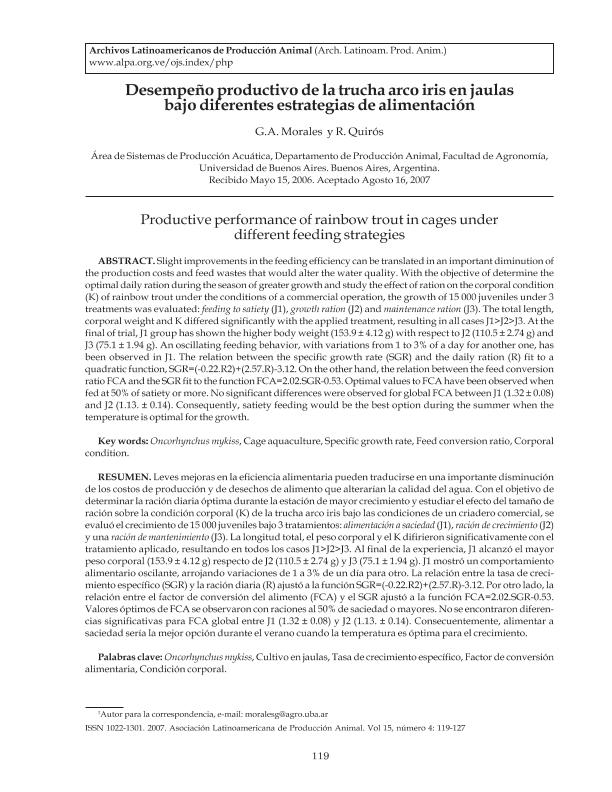Artículo
Slight improvements in the feeding efficiency can be translated in an important diminution of the production costs and feed waste that would alter the water quality. With the objective of determine the optimal daily ration during the season of greater growth and study the effect of ration on the corporal condition and dispersion of weight statures under the conditions of an commercial aqua farm, the growth of 15 000 trouts under 3 treatments was evaluated during 4 weeks: feeding to satiety (J1), growth ration (J2) and maintenance ration (J3). The total length, corporal weight and corporal condition factor differed significantly with the applied treatment, resulting in all cases J1>J2>J3. The J1 group (153.9 ± 4.12 g) demonstrated the greater dispersion of weight statures, with respect to J2 (110.5 ± 2.74 g) and J3 (75.1 ± 1.94 g). An oscillating feeding behavior, with variations from 1 to 3% of a day for another one, has been observed in J1. The relation between the specific growth rate (SGR) and the daily ration (r) fit to a quadratic function, SGR=(-0.26.R2)+(2.64.R)-3.06. On the other hand, the relation between the feed conversion ratio FCA and the SGR fit to the function CA=(0.35.SGR2)-(1.83.SGR)+3.48. The optimal R was 2.9%. However, were not significant differences for global FCA between J1 (1.32 ± 0.08) and J2 (1.13. ± 0.14). Therefore, satiety feeding would be the best option during the summer when the temperature is optimal for the growth. Leves mejoras en la eficiencia alimentaria pueden traducirse en una importante disminución de los costos de producción y de desechos de alimento que alterarían la calidad del agua. Con el objetivo de determinar la ración diaria óptima durante la estación de mayor crecimiento y estudiar el efecto del tamaño de ración sobre la condición corporal (K) de la trucha arco iris bajo las condiciones de un criadero comercial, se evaluó el crecimiento de 15 000 juveniles bajo 3 tratamientos: alimentación a saciedad (J1), ración de crecimiento (J2) y una ración de mantenimiento (J3). La longitud total, el peso corporal y el K difirieron significativamente con el tratamiento aplicado, resultando en todos los casos J1>J2>J3. Al final de la experiencia, J1 alcanzó el mayor peso corporal (153.9 ± 4.12 g) respecto de J2 (110.5 ± 2.74 g) y J3 (75.1 ± 1.94 g). J1 mostró un comportamiento alimentario oscilante, arrojando variaciones de 1 a 3% de un día para otro. La relación entre la tasa de crecimiento específico (SGR) y la ración diaria (R) ajustó a la función SGR=(-0.22.R2)+(2.57.R)-3.12. Por otro lado, la relación entre el factor de conversión del alimento (FCA) y el SGR ajustó a la función FCA=2.02.SGR-0.53. Valores óptimos de FCA se observaron con raciones al 50% de saciedad o mayores. No se encontraron diferencias significativas para FCA global entre J1 (1.32 ± 0.08) y J2 (1.13. ± 0.14). Consecuentemente, alimentar a saciedad sería la mejor opción durante el verano cuando la temperatura es óptima para el crecimiento.
Desempeño productivo de la trucha arco iris en jaulas bajo diferentes estrategias de alimentación
Título:
Productive performance of rainbow trout (Oncorhynchus mykiss) in cage culture under different feeding strategies
Fecha de publicación:
12/2007
Editorial:
Asociación Latinoamericana de Producción animal
Revista:
Archivos Latinoamericanos de Producción Animal
ISSN:
1022-1301
e-ISSN:
2075-8359
Idioma:
Español
Tipo de recurso:
Artículo publicado
Clasificación temática:
Resumen
Archivos asociados
Licencia
Identificadores
Colecciones
Articulos(OCA PQUE. CENTENARIO)
Articulos de OFICINA DE COORDINACION ADMINISTRATIVA PQUE. CENTENARIO
Articulos de OFICINA DE COORDINACION ADMINISTRATIVA PQUE. CENTENARIO
Citación
Morales, Gabriel Alejandro; Quiros, Rolando; Desempeño productivo de la trucha arco iris en jaulas bajo diferentes estrategias de alimentación; Asociación Latinoamericana de Producción animal; Archivos Latinoamericanos de Producción Animal; 15; 4; 12-2007; 119-127
Compartir




